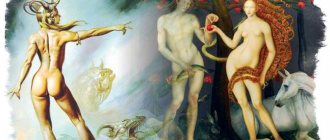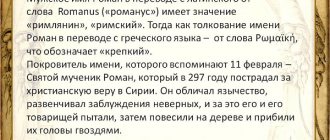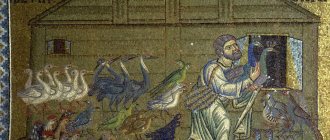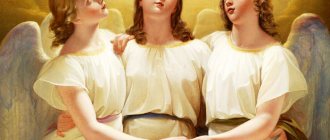Hello everyone, friends.
I propose to analyze the concept of Lucifer in the mode of synthesis and analysis of the information that is available about this character. The information is quite contradictory and, if you do not follow the lead of the same commentators on the Bible or other sources, many interesting factors are revealed.
Looking ahead, I will ask one question - who punishes a person for his sins, Lucifer or the Heavenly Father? Lucifer is the executor of God's will and nothing more. But this is a preface that does not require an answer. We know that Lucifer is in eternal conflict with the Heavenly Father and at the same time fulfills his will... How to understand this?
Lucifer, who is it?
Lucifer Rising
Lucifer's life after the fall
Lucifer, Satan, Man
Lucifer, - Humanity
The mystery of the name
From Latin the translation sounds like “to bring light.”
In the myths of the ancient Romans, he was personified with the image of the morning dawn, the morning star (the star of Lucifer is the planet Venus). The planet Venus was called Lucifer because it “brought light” when there was no sun (early morning and late evening). However, in the Christian religion since about the seventeenth century, Lucifer is a fallen angel who was associated with evil spirits (the devil, Satan). It is interesting that in the Roman Empire men bore the name Lucifer. Its meaning was “shining, bringing light.” There was even Saint Lucifer, a bishop who lived in the fourth century AD. In the Christian religion, Lucifer has a negative connotation.
In one of the books, written in Hebrew, there is a legend about Lucifer. Allegedly, one angel wanted to be equal to God, for which he was “chased out” from heaven. This is how Lucifer became a “bad hero” who has many guises in the Bible.
Modern interest
Now the image of Lucifer remains bright and arouses interest. On Wikipedia you can find a whole chapter dedicated to the mythical character; on the Internet there are many images and paintings by different artists that have a unique colorful description. If you wish, you can even find photos taken by fans and researchers of this topic.
Esotericism, from a position of firm belief in the existence of the supernatural, has countless rituals, studies, and appeals to the fallen angel to achieve various goals.
Name letter meanings
L – artistic and inventive individuals. They prefer to be guided by logical thinking in their actions. They know how to win over. In rare cases, they are narcissistic and disdainful of other people. It is extremely difficult to endure separation from loved ones. They are overly capricious and require increased attention to their person. Yu – conservatism, fear of everything new, tendency to idealize people. These people are very romantic and often sacrifice themselves in relationships. Despite this, they are prone to very tough actions. The main goal of their life is the search and knowledge of the truth. These people prefer to make friends with people who are older than them and have similar interests. C – ambition, the desire to always be the first in everything. These people themselves are quite romantic and dreamy people. They are not able to be alone for a long time. In the most hopeless situations they can instill hope for a bright future. And - subtle mental organization, romance, kindness, honesty and peacefulness. Representatives of the fair sex pay a lot of attention to their appearance, while men focus on internal qualities. They manage to achieve great success in science and working with people. Very economical and prudent. F - perfectly adapt to environmental conditions. Always have lots of great ideas. In their stories they are able to embellish and lie a little. They really love helping people. There's never a dull moment with them. Their life is always filled with many interesting events. E – sociability, insight, commercialism and selfishness. Owners of this letter are able to win people over. They are simple and charming at the same time. They constantly strive for a good life, which they value more than friendship. They realize themselves well in creative professions. They are interesting conversationalists. R – people with the letter “R” in their name have extraordinary thinking. They are very responsible and you can rely on them in any situation. They have well-developed intuition and have an extremely negative attitude towards lies. They constantly strive for leadership, but in family relationships they rely on their partner.
Talismans
Like any other name, there are things that bring good luck to Lucifer. Talismans, colors, stones - all this can make the wearer’s existence easier. A strong name requires the same “patrons”.
Lucifer's colors are rich black and deep red. They bring not only good luck, but also help to cope with temperamental shortcomings. The numbers 5, 8, 12 and 35 are also lucky numbers.
Saturn and Mars are the patron planets of Lucifer. Lucky metals are tin and iron. Astrologers note that the name is ideal for boys who were born under the signs of Scorpio or Capricorn.
Stones such as opal, quartz, calcite and coral are great for Lucifers. Red or black roses planted at home will bring good luck. The best pet is a cat. Using these simple tips and surrounding yourself with luck, you can hope for a better fate.
Character
Men named Lucifer are born to dominate. Always and everywhere they strive to become the main ones. Regardless of how justified such a desire is, a person with this name will strive for leadership. At the same time, the opponent’s strength does not frighten him at all, but only provokes him. Over time, only the scale of aspirations will change, but Lucifer’s life motto will always be “Stronger, higher, faster.” A man named Lucifer has a bright personality and a clearly expressed desire to realize himself. It is these motives that he is guided by when making his choice. However, the presence of a large number of possible solutions from which only one correct one needs to be chosen can confuse him. A person with this name must be able to focus on a specific goal in order to direct all his forces in one direction and achieve results. Trying to do several things at once does not end well: he only risks scattering his efforts and being left empty-handed. Lucifer's worst enemy is his tendency to hesitate. In addition to the colossal desire to carry out his plans and considerable opportunities, he must also have the courage to make difficult choices.
The Creator's Wrath and Fall
The first of the angels decided that he had the right to decide for himself what people needed. Knowing the prohibition given to Adam and Eve to touch the tree of knowledge, but disobeying it, Dennitsa entered the wonderful garden in the form of a serpent. He persuaded an innocent woman to try the fruit of knowledge and thereby pushed the first people to commit sin.
The Lord demanded an answer from his beloved son. But He saw a heart filled with pride and a consciousness swallowed up in darkness. Angry, the Creator cursed Dennitsa and threw him from heaven into the underworld for eternal punishment. This betrayal also divided the angelic army. Not wanting to leave his beloved mentor, not having the strength to believe in his disobedience, one third of him ended up on the side of Dennitsa. There was a fall of angels from heaven. Their leader was Lucifer, who had lost his radiance, and scolded the concepts given by the Creator about justice, about love, about truth.
Pride gave rise to a selfish desire to be above everyone else, stronger than everyone else, to dictate one’s will, to rule the whole world and served as the main reason for the fall. The admiring attitude of his inferior brothers, their strong love, their prayers strengthened Lucifer’s pride and confirmed his thoughts about his exceptional perfection.
Bibliography
Major writings of Lucifer against the Arians:
- Epistola ad Catholicos
("Epistle to the Catholics"; c. 355, lost) - Epistola ad Eusebium
(“Epistle to Eusebius”; 355) - De non conveniendo cum Haereticis
("On disagreement with heretics"; c. 357) - De Regibus Apostolicis
("On the kingdoms of the apostates"; 358) - Ad Constantium Augustuum pro Sancto Athanasio, Libri II
or
De Athanasio
(“To Augustus Constantine on Saint Athanasius, 2 books” or “On Athanasius”; 360) - De non parcendo in Deum delinquentibus
(“On the unsalvation of those who deviate from God”; 360) - Moriundum esse pro Dei filio
("Be ready to die for the Son of God"; 361) - Epistola ad Florentium Magistirum Officiorum
("Message to Florence, Master of the Office"; 361)
Lucifer quotes extensively from the Bible in his works and is therefore a useful source for Vetus Latina.
Literature
- Blunt JH
[archive.org/details/dictionarysects00blungoog Dictionary of Sects, Heresies, Ecclesiastical Parties, and Schools of Religious Thought]. — Rivingtons, 1874 - Cross, F. L. ed. The Oxford Dictionary of the Christian Church.
New York: Oxford University Press, 1978. - Englebert, Omer. The Lives of the Saints.
Christopher and Anne Fremantle, trans.
New York: Barnes & Noble Books, 1994. Nihil obstat
,
Imprimatur
1951. - Diercks, G. F. ed. Luciferi Calaritani Opera quae supersunt
, Turnhout: Brepols, 1978. - Krüger G.
[archive.org/details/luciferbischvon00krgoog Lucifer, Bischof von Calaris, und das Schisma der Luciferianer]. — Leipzig: Breitkopf & Härtel, 1886 - Kartashev A.V.
Ecumenical Councils. - M.: Republic, 1994. - ISBN 5-250-01847-5 - Catholic Encyclopedia. T. II. - M.: Franciscan Publishing House, 2005. - ISBN 5-89208-054-4
- Filippov I. S.
Mediterranean France in the Early Middle Ages. The problem of the formation of feudalism. - M.: Scriptorium, 2000. - ISBN 5-94448-002-5
Links
- [books.google.com/books?id=Zy8RAAAAYAAJ Opera Omnia CSEL 1886 from Google Books]
- [books.google.com/books?id=NPnJCNIkxuAC Opera Omnia Migne 1845 from Google Books]
- [www.documentacatholicaomnia.eu/30_10_0347-0354-_Lucifer_Episcopus.html Opera Omnia Migne 1885 PDF text-only, readable only]
- [www.fourthcentury.com/index.php/lucifer-chart List of the writings of Lucifer in English]
- [www.newadvent.org/cathen/09410b.htm Lucifer of Cagliari - Catholic Encyclopedia]
- [www.treccani.it/enciclopedia/lucifero-di-cagliari_%28Enciclopedia-Italiana%29/ LUCIFERO di Cagliari - Enciclopedia Italiana]
Story
According to the most common version, Lucifer is the name of the devil, or Satan, which he still bore during the fall, but retained in the future. The Latin word “lucifer” (“light-bearer”), by analogy with the Greek “eosphoros” (“bringer of the dawn”), designated Venus as the morning star (star), and it was this word that was used to translate the Hebrew name of this planet — “gelel” (lit. “shining one”) - in verses 14:12-15 from the Book of the prophet Isaiah:
How you fell from the sky, Lucifer, son of the Dawn! crashed to the ground, trampling the nations! And he said in his heart: “I will ascend into heaven; I will exalt my throne above the stars of God and sit in the assembly of the gods, on the edge of the north; I will ascend to the heights of the clouds, I will be like the Most High,” but you are cast down into hell, into the depths of the underworld.
The same word "lucifer" is used in the Latin Bible to designate the morning star without any connection with the devil (II Pet. 1:19), and in Rev. 22:16 Jesus himself calls himself the “morning star”: “I am the root and descendant of David, the bright and morning star (stella splendida matutina).” Moreover, the expression “morning star” became one of the traditional titles of the Virgin Mary, the “star of the morning” - the harbinger of Christ - was called John the Baptist, and in the Catholic Easter hymn "Exsultet" ("Proclamation of Easter") the Latin word "lucifer" is used in praise of Easter candles:
Let this flame burn until the Light-Bearing Star (lucifer),
to that single light-bearing star that never sets -
Christ, your Son, who, having ascended from the abode of death, illuminated the human race with its peaceful light
and lives and reigns forever and ever.
However, despite all this, verses from the Book of the Prophet Isaiah, which initially represented a prophecy about the destruction of Babylon, already in the 2nd-3rd centuries. AD were interpreted by Christian exegetes as describing the fall of Satan, and the word "lucifer" became the personal name of the devil. In this meaning it was used by Tertullian and Origen, and after them by Jerome, Augustine the Blessed and other church fathers. However, there has not been a consensus among theologians and demonologists about whether the demon Lucifer is identical to the devil-Satan or not.
The theological tradition has tried in one way or another to resolve the paradox associated with the contradiction between the name and essence of this demon. Lucifer was conceptualized as a demon of the planet Venus, hiding behind his radiant external beauty internal depravity - exorbitant pride, arrogance, narcissism, vanity and envy of God, which became the cause of his fall. The idea developed that after the fall, this most beautiful of seraphim turned into the ugliest and most monstrous of all the spirits of hell. Joost van den Vondel in the tragedy “Lucifer” (1654) describes this transformation as follows:
As at the behest of a magic wand
Upon his overthrow, the beauty of the Enemy disappeared:
He was covered in stinking mud in a brief moment, His luminous face became a terrible muzzle, His lips bared with fanged jaws of a beast, Each limb appeared as a vile paw, His entire skin was overgrown with black bristles, Creepy dragon wings shot up... ...The former ruler became a target for curses of God, and people, and fellow Angels, and the terrible face of the one who fell into the void
was covered with perspiration, in steaming sweat.
It was believed that in the underworld, Lucifer himself continuously experiences terrible torment and at the same time punishes the souls of the worst sinners. This is exactly how he is described in the vision of the Irish knight Tnugdal (XII century):
... she [the soul of Tnugdal] saw the prince of darkness himself, the enemy of the human race, the devil, who was larger in size than all those animals that she had previously seen. The enormity of his body could not be compared with anything by the soul itself, which saw him <...> The said beast was black as a raven, wearing a human form from head to toe, with the exception of the fact that it had a tail and many arms. Namely, this terrifying monster had no less than a thousand arms, and each arm was about a hundred cubits long and ten cubits thick. Each hand was equipped with twenty fingers, which fingers were a hundred palms long and ten palms thick; the claws were iron and longer than military pikes, and there were the same number of claws on the legs. Its beak is extremely long and thick, its tail is very hard and long and studded with prickly needles to destroy souls. This huge marvel lies flat on an iron grate, under which are placed red-hot coals, fanned by the bellows of countless demons. He himself is surrounded by so many souls and demons that it would seem incredible to anyone that the world from its beginning would give birth to so many souls. The said enemy of the human race is bound at all members and joints with iron and copper chains, red-hot and very thick. So, writhing on the coals and being burned on all sides, inflamed with great rage, he turns from side to side, stretches out all his hands to the crowd of souls and, having picked up full handfuls, squeezes them, just as a villager, tormented by thirst, squeezes out grapes. , so that not a single soul can escape unharmed, so as not to be torn apart or deprived of its head, arms, legs... Then, as if sighing, it blows and scatters all the souls in different directions of Gehenna <...>. And when the ferocious beast inhales the air again, it pulls back all the souls that it has just scattered, and devours those that fall into its mouth along with smoke and brimstone. If someone escapes his hands, then, striking with his tail, the unfortunate beast hits them, constantly hitting himself, and thus, causing suffering to souls, he himself suffers.
Seeing this, the soul said to the angel of the Lord: “I ask you, my lord: what is the name of this monster?” In response, the angel said: “The beast you see is called Lucifer; he is the first of God's creatures and dwelt among the delights of paradise. If he were free, he would shake both heaven and earth to their foundations.” <...> And the soul said: “I would like to know for what reason this monster is called the prince of darkness, while he is unable to protect anyone and cannot save himself.” And the angel said: “He is called a prince not because of power, but because of the primacy that he has in the kingdom of darkness. Although you have seen many punishments so far, they are all considered nothing if you compare them with this merciless torture.”
Lucifer appears in a similar position of executioner and executed in Dante. In The Divine Comedy he is placed in the last, ninth, most terrible circle of hell and is traditionally depicted as having three heads (as a monstrous parody of the Holy Trinity):
Lord of the tormenting power
His chest made of ice heaved halfway;
And the giant is closer to me in stature than the hands of Lucifer are to the giant; Based on this part, you yourself would have calculated what he is like, his whole body sunk into the ice floe. Oh, if he raised his eyelids to the Creator and was as wondrous as he is now terrible, He is truly the root cause of evil! And I became speechless from amazement, When I saw three faces on it; One is above the chest; its color was red; And above one and above the other shoulder, two adjacent to this one threatened to the sides, Closing at the back of the head under the crest. The face to the right was white and yellow; The color on the left was like those who came from the Nile waterfalls. Under each grew two large wings, As should a bird so great in the world; The mast did not carry such sails. Without feathers, they looked like bats; He blew them, moving the ramen, And drove three winds along the dark expanse, The streams of Cocytus chilled to the bottom. Six eyes were streaming with tears, and bloody saliva was flowing from three mouths. They all three tormented, as if they were flapping, For a sinner;
so, on each side, one by one, three of them languished (“Hell”, XXXIV.28-57)
It was assumed that the three heads of Lucifer symbolize one or another of the mortal sins that led to his fall, or anger, envy and impotence as the antithesis of divine mercy, love and power. The main sin associated with Lucifer is pride, but, according to some ideas, this demon, like Beelzebub, personifies all seven deadly sins, as in the tragedy of Joost van den Vondel:
He, the one who ruled so proudly, so arrogantly,
He revealed seven animals at the same time:
Now in his guise he seemed like a gluttonous pig; an arrogant lion; A donkey in laziness; a dragon in zealous anger; A monkey burning with lust; The angry rhinoceros was here, and, finally,
the wolf, the ruthless miser, was also visible.
Some demonologists argued that after the fall, Lucifer changed not only his appearance, but also his name, and is now called Lucifuge (literally, “runner of light”). This name appears in some magical treatises and historical texts of pacts with the devil. For example, in the Grand Grimoire, which explains in detail how to summon the emperor of the underworld and make a pact with him, the names "Lucifer" and "Lucifuge Rofocal" are initially used interchangeably. However, later in the same book, Lucifuge turns out to be “the first minister of the underworld, to whom Lucifer entrusted power over all the riches and treasures in the world,” and Lucifer, in turn, is the emperor of hell, characterizing himself as follows:
I, Lucifer, am the most powerful emperor, supreme and autocratic, free and perfect ruler of the entire underworld, autocratic master over all my vast possessions, formidable, noble ruler, judge of all destinies and all troubles, knowledgeable and wise and endowed with all the highest and most radiant virtues , the pacifier of Europe and Asia.
In the True Grimoire, Lucifer also appears as the emperor of the infernal power, the head of the triumvirate of supreme demons. Probably from these two sources, de Plancy drew the idea that Lucifer rules Europe and Asia and, when summoned by a spellcaster, appears in the form of a beautiful boy or youth, devoid of any monstrous features, but blushing or bursting with fire in anger. According to these grimoires, the main benefit of Lucifer was the ability to reveal to the caster the location of treasure. The instructions that Lucifer should be invoked on Monday by sacrificing a mouse to him are borrowed from the Grimoire of Honorius, which is similar in content to these treatises. The natural association of Lucifer with the East is found in the “People's Book” about Doctor Faustus (where this demon is given a red, fiery color - and a surprisingly inexpressive appearance compared to other descriptions: “He was the height of a man, hairy and shaggy, like a red squirrel , and the tail sticks out like a squirrel").
In 16th-century classifications linking the power of demons with certain periods of the year, Lucifer was assigned the month of May. In Agrippa's Occult Philosophy, "Lucifer" is used as a name for a demon only once - as part of a four-part classification based on the letters of the Tetragrammaton. Here it correlates with the first letter (Yod), to which Agrippa also corresponds to the Sun, heart and World Soul. (In all other references, the word “Lucifer” or “Lucifera” means in Agrippa the morning Venus, foreshadowing the rising of the Sun, and was once even used as a synonym for the Sun itself.)
In other Kabbalistic classifications, Lucifer appears as the leader of the third demonic rank - the so-called “sheltering” or “hiding” ones, which are opposed by the angels of Binah, the 3rd sephira of the Tree of Life. In the “Ancient Fragment of the Key of Solomon” these demons are described as spirits of “stupidity, dullness of mind and Obscurity”, and their leader is said to be “Lucifugus, falsely and contrary to the meaning called Lucifer (just as the Greeks called the Furies Eumenides - “Merciful”).” In another of Levi's works, The Secrets of the Qabalah, Lucifer is related to the highest sphere of the Tree of Life, Kether: "Instead of the Crown of the Sephiroth, Lucifer reigns here, whose symbol, the inverted pentagram of Remphan, is the sign of despotism."
In the 19th-20th centuries, under the influence of the romantic tradition and Nietzscheanism, Lucifer was reinterpreted as the Christian equivalent of Prometheus, which also affected his perception in occult circles. Departing from traditional interpretations, Eliphas Levi in “The Doctrine and Ritual of High Magic” uses the word “Lucifer” as one of the synonyms of “the great magical agent <…>, also known under the names “Tetragram”, INRI, “Nitrogen”, “Ether” , “Od”, “Magnetic Fluid”, “Soul of the Earth”. This “agent” is paradoxically dual and therefore neutral:
...he serves both good and evil; he both conducts light and spreads darkness; he can equally be called both Lucifer and Lucifuge; he is a serpent, and he is also a halo; he is fire, but he can equally appear as the raging element of the underworld, and as the flame of a burnt offering ascending to heaven.
Further considering Lucifer as the personification of the forces of light and fire, Levi notes that in the mystical teachings of the Kabbalists this is “not a cursed and lost angel; he is an enlightening angel, reviving with fire; before the angels of peace he is the same as a comet before the gentle stars of the spring constellations,” and in an allegorical apology he glorifies this comet as “the messenger of the suns” and “the eternal wanderer, into whose power infinity is given.” Just as theologians likened John the Baptist to the morning star who anticipated the coming of the Messiah, so Levi declares the Promethean rebellion and the fall of Lucifer as the heralding of the descent of Christ into the material world.
In a similar vein, Lucifer is presented in the “Secret Doctrine” of H.P. Blavatsky (it was no coincidence that she named the journal of the Theosophical Society after him). Referring, like Levi, to Kabbalistic sources, Blavatsky notes the essential duality of this image: the prince of demons “is called Samael, the Angel of Death, and he is also the Seducing Serpent, Satan; but this Satan is also Lucifer, the beautiful Angel of Light, the bearer of Light and Life, a “soul” alienated for a time from the Saints, other Angels, awaiting the time when they will descend to Earth, in order to incarnate in their turn,” after which also draws a parallel between Lucifer and Christ and assigns to the former classical “Promethean” functions:
Lucifer is the bearer of insight and freedom of thought - a metaphorical beacon that helps a person find his way through the reefs and shallows of Life, for in his highest aspect Lucifer is the Logos, and in his lowest he is the “Adversary”. Both of these aspects are reflected in our Ego. Lactantius, speaking of the Nature of Christ, represents the Logos, the Word, as “the firstborn brother of Satan and the first among all creatures” <…> Lucifer, or the “Light-Bearer”, is in us: this is our mind, our tempter and redeemer, our rational liberator and a savior from pure animality. Without this principle <...> we would undoubtedly be no better than animals.
Lucifer, reinterpreted as a spirit-liberator and opponent of the usurper god Yahweh (who, in turn, is likened to the demiurge of the Gnostics) becomes one of the central divine images in some modern “left-hand path” systems. Thus, Thomas Carlsson identifies the opening of the "Eye of Lucifer" with the classical experience of enlightenment, analogous to achieving the degree of Temple Master in the Thelemic system, and Michael Ford defines a follower of the Luciferian path as one who "begins his movement in darkness, masters the lower aspects of his essence, and then strives to illuminate this darkness with the light of imagination - the flame of consciousness and individuality, which is called Black Fire."
Symbol of Lucifer
Lucifer, of course, has his own symbol. The seal of Satan has long been considered such a sign. It is a kind of pentagram, in the core of which a goat’s head can be seen. From each acute corner of the pentagram the word “Leviathan” is written. This is one of the names of Lucifer.
Photo: https://unsplash.com/
People take the pentagram seriously. It is believed that if you draw it correctly and perform a certain ritual, then Satan Lucifer himself will appear in his guise. Nowadays, the symbol is used on television as the main appeal of the devil. Magicians and witches show rituals in programs.










